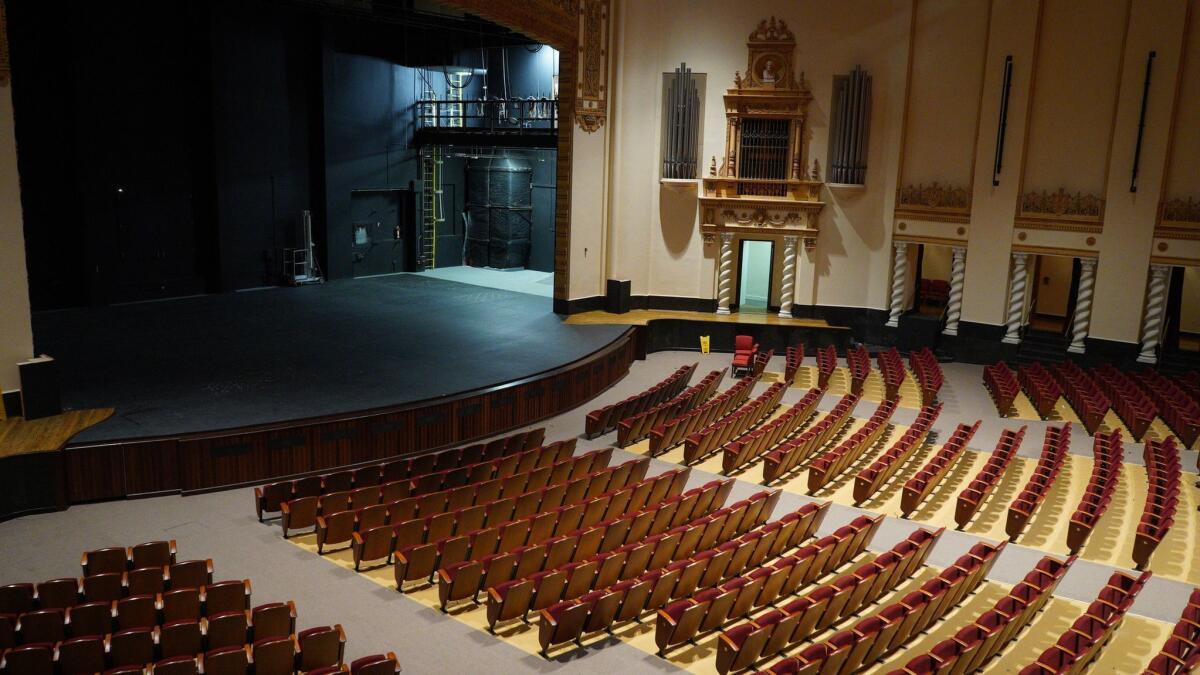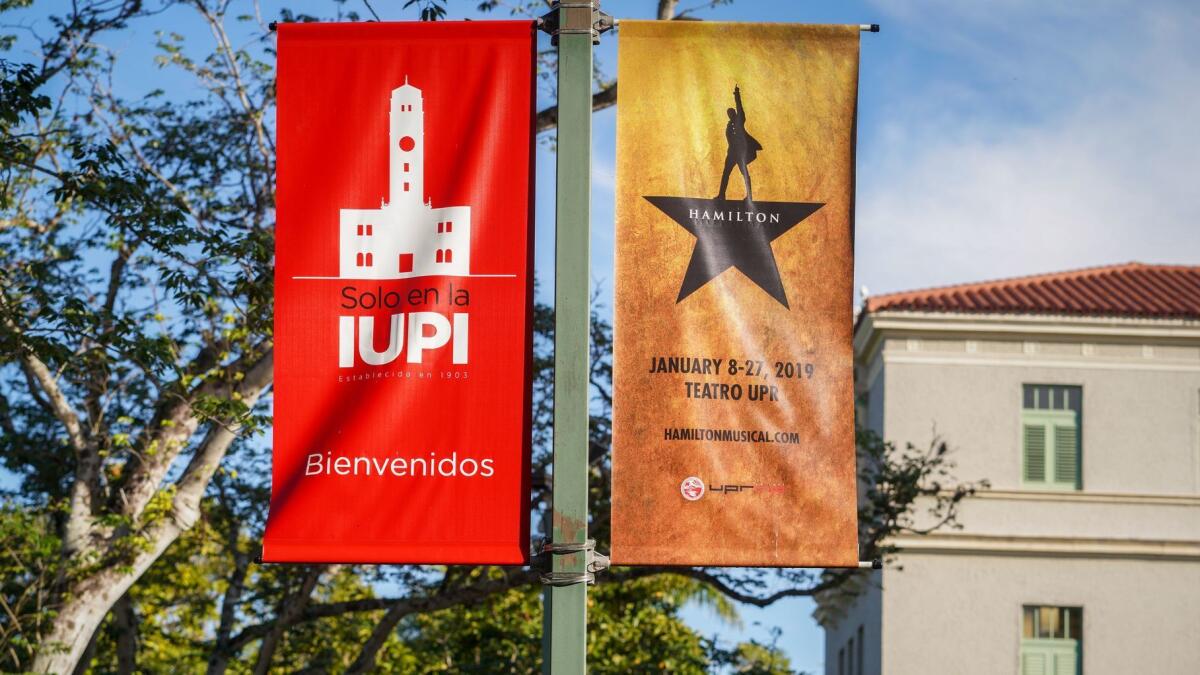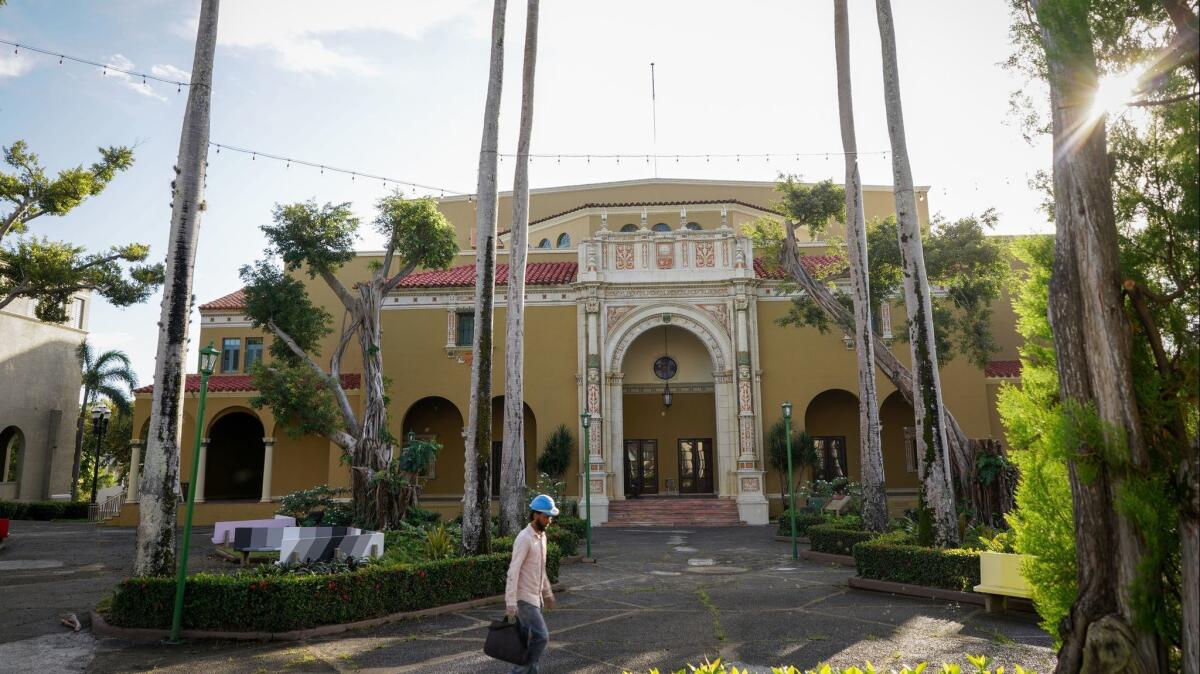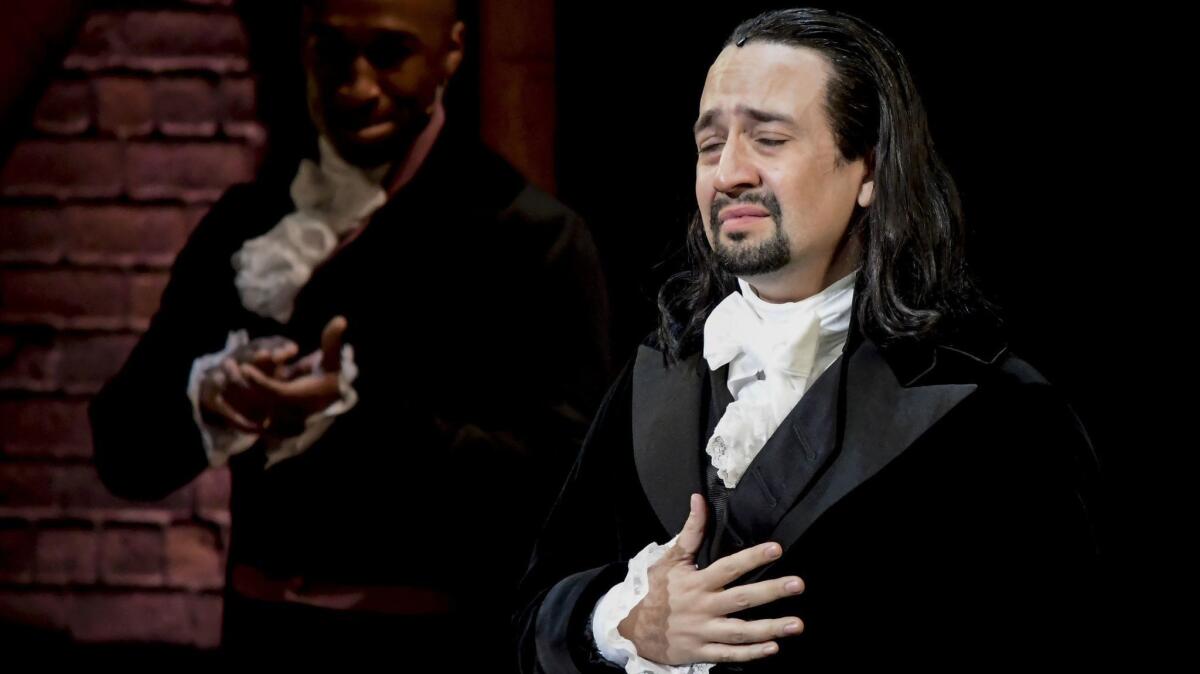At the Puerto Rico theater that ‘Hamilton’ left behind, disappointment stands center stage

- Share via
SAN JUAN, Puerto Rico — The quadrangle in front of the historic Teatro de la Universidad de Puerto Rico is so quiet that you can hear a feral cat meowing as it lounges on the theater steps.
The plaintive sound echoes across the empty plaza with its freshly painted benches in joyful shades of yellow, red, pink, orange and blue.
This humid, eerily windless afternoon was not supposed be so lifeless. Previews had been scheduled to begin for Lin-Manuel Miranda’s “Hamilton,” the Broadway hit coming to Puerto Rico to raise money and spirits for hurricane-ravaged communities here. Miranda was to reprise the title role and lead a passion project aiding the island where his family has its roots and where he spent summers as a child. The quadrangle was supposed to be teeming with fans picking up their tickets for Puerto Rico’s cultural event of the year — if not the decade.
Instead, university communications director Mario Alegre Barrios is standing in the center of the sprawling space, blinking in the relentless sunlight and talking about what never came to be.
After more than a year of planning by university administration, students and show producers, “Hamilton” announced on Dec. 21 — less than a month before opening night — that it was relocating the production to Centro de Bellas Artes Luis A. Ferré, a cultural center about five miles away, to avoid the threat of union unrest and campus protests over rising fees. On Dec. 27, crews came to remove the sets that had been in place for much of the month. Three days later, all that remained were the light post banners proudly trumpeting a show that no longer was coming.
“We have a breakdown,” Barrios says, describing the collective reaction to a move that left many at Teatro UPR reeling. “It was a very hard time. Some people cried. Some people don’t believe it.”

After all, Miranda announced mere weeks after Hurricane Maria that he intended to bring “Hamilton” to Teatro UPR. Ultimately $1 million was pledged to rebuild the theater, which suffered massive damage in the storm.
In the university’s first public comments about the “Hamilton” venue change, Barrios chose his words carefully. Is the university grateful for the money that “Hamilton” is raising? Yes, of course. But is there still a raw, deep and abiding hurt over the show’s departure from campus? Absolutely.
The feeling of betrayal is pervasive at Teatro UPR, though few will speak on the record. Miranda is a hero to the island and they wish him well, but critics — who wouldn’t speak publicly out of fear of appearing ungrateful or facing reprisals — said that if “Hamilton” really wanted to stay on campus, it could have.

“HAMILTON”: How a black silhouette became the musical’s iconic image »
Teatro UPR representatives estimated that the loss of “Hamilton” cost the university nearly $500,000, including $10,000 per night that the 17-show run was to pay in theater rental fees, plus lucrative sponsorships from the likes of AT&T and American Express as well as fees paid for equipment rentals. The student body had been granted the exclusive right to sell bottled water throughout the run, which would have resulted in $20,000 to $30,000 in profits for student activities, Barrios said.
The loss also left many at the university fearing that other prominent touring productions would no longer consider bringing their work to Teatro UPR.
“How do you plan to come here if you have the doubt?” Barrios asks. “If this happened to ‘Hamilton,’ any other production would do the same.”
He points out the place where a 36-foot-long stage was to be erected for pre-curtain performances by students called “Solo en la IUPI,” or “Only in the IUPI,” the colloquial name for the campus in the Rio Piedras neighborhood where the 1939 theater sits.
“We thought it would be a huge opportunity to show what is the university besides ‘Hamilton,’” Barrios says. Because guests would have to pick up their tickets before each show, the university had planned to perform for a captive audience from about 4:15 to 7 p.m. every day.
Drama students, choral singers and band musicians were on the program, along with guitar, percussion and jazz acts. Wine and cheese were to be served. “Hamilton” memorabilia was to be sold in the university art gallery.
Now the theater — with its plush red seats and freshly repaired roof — stands as a metaphor for the greater challenges of hurricane recovery, which has been painfully slow and often incomplete. The place has been fixed up nicely yet stands empty and forgotten, at least for now, and those who run it fret about its future. It remains an example of the political discord and social upheaval that has plagued Puerto Rico since the hurricane, the worst natural disaster in island history.

The trouble started when the university labor union Hermandad de Empleados Exentos No Docentes sent a letter to Miranda on Nov. 29 warning of a potentially explosive dispute over student fee hikes for relatives of employees and the slashing of employee benefits, including retirement. Complicated island rules prevent police from easily coming onto university campuses, and suddenly the producers of “Hamilton” found themselves fearful of how protests might affect the security of the cast and the audience.
Miranda’s father, Luis Miranda, was so alarmed that he immediately flew to the island from New York City. When he met with union leaders, he said, they warned him that their collective bargaining contract was bigger than “Hamilton.”
“Lin-Manuel and I — all of us — understand that is true,” Luis Miranda said in a phone interview. “The collective bargaining relationship that they have is unrelated to ‘Hamilton,’ and we understood that they wanted to use this juncture as a pressure point, and we did not want to be part of that very difficult situation that they have had for the past few months.”
Despite later assurances from the union that it would wait to stage any strike or protest until after the show’s run, the production decided to err on the side of caution.
“When Bellas Artes became an option, we took it,” Lin-Manuel Miranda said during a news conference after the show’s splashy opening Friday, which drew the likes of Jimmy Fallon and Shonda Rhimes.
The notion of protest is inherent in American democracy and also in the musical itself, lead “Hamilton” producer Jeffrey Seller acknowledged, adding that he is supportive of the union’s right to demonstrate. But given the possibility of protests and the difficulty of having a police presence, the production had to move, he says.
“Once I understood the variables, it was a clear decision,” he says. “It was a painful decision, but it was a clear decision.”
The hurt was amplified because Teatro UPR is Luis Miranda’s alma mater and because both Mirandas considered the university the cultural heart of the island. For 80 years it has hosted the crème de la crème of artistic talent. Los Angeles Philharmonic conductor Gustavo Dudamel has appeared here. Plácido Domingo and Luciano Pavarotti too.
Producers had to consider the time it would take to dismantle sets already built inside Teatro UPR, Luis Miranda says. When the production decided to move, it had to move fast.
“That added to the feeling of being left at the altar after a year of courtship,” he says. “The guests are coming to the wedding, the reception is set up, and the bride or the groom — or whatever you want ‘Hamilton’ to be — said, ‘We cannot get married.’ It was so difficult.”
Luis Miranda recalled university protests in the 1970s in which a student died. He says he simply could not take that kind of risk. His son agrees.
“If there’s the slightest chance something goes wrong, I cannot have that on my conscience,” Lin-Manuel Miranda says. “Whether it’s a student or anybody, I can’t have anybody getting hurt on my head.”

ARCHIVE: When “Hamilton” came to Hollywood »
At the opening night performance at Bella Artes — in the Santurce neighborhood of San Juan where the night before the popular trap singer Kevin Fret was shot dead — dozens of police officers are present. Cruiser lights flash on every corner, and the blocks surrounding the venue are on virtual lockdown as Uber vehicles and black town cars crawl toward the entrance.
Barrios, the university communications director, is not among the guests in attendance. He got his money back for his ticket to one of three preview performances — all canceled following the tumult of relocation. However, university Chancellor Luis A. Ferrao sits in the fourth row and is treated graciously by representatives for the Miranda family’s philanthropic organization, Flamboyan Arts Fund, which provided the money to renovate Teatro UPR.
Flamboyan’s support for the university and the theater is not going away, Luis Miranda adds. The foundation presented the administration with 30 tickets to the show to sell for $5,000 each — an attempt to make up for the money lost due to the cancellation. Plans are afoot to provide more financial aid for three years as the university continues to rebuild, he says.
Meanwhile, Teatro UPR is working to move on, says Barrios and the theater’s executive director, Rafael O. Chavez.
“It was like a dream, the ability to do a big project,” Chavez says, recalling the anticipation surrounding “Hamilton.” The challenge now is to prove that other dreams are still possible in the months and years to come.
More to Read
The biggest entertainment stories
Get our big stories about Hollywood, film, television, music, arts, culture and more right in your inbox as soon as they publish.
You may occasionally receive promotional content from the Los Angeles Times.











